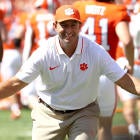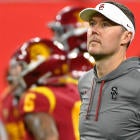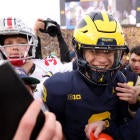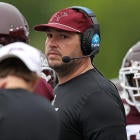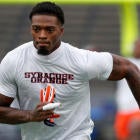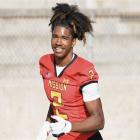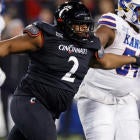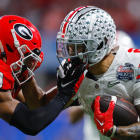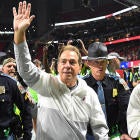
DESTIN, Fla. -- Thirteen years ago, Trev Alberts was forced to make one of the most difficult decisions in his career.
Nebraska-Omaha's athletics department was facing severe financial shortfalls, and transitioning sports from Division II to Division I had only compounded the multi-million dollar math problem. As the athletics director, Alberts had two options.
"Make draconian cuts or the whole thing was going down," Alberts, now at Texas A&M, remembers. "We couldn't save it all, but we saved what we could."
So he cut football and wrestling, two sports that had produced eight national titles and the NFL's first black quarterback, to save costs. The decision at the small school was barely a blip on the national radar, but it was world-ending news for dozens of athletes whose careers suddenly came to an end because of a sudden shift in the competitive landscape. Boosters and fans were upset, and years later those feelings intensified when an internal memo from UNO's president revealed the department had "a historic lack of fiscal discipline."
Now imagine similar decisions being made in the ACC or the Big 12, or maybe even inside the big and mighty Big Ten and SEC.
As outrageous as it seems, administrators across major college athletics are preparing for the worst as many programs already strapped for cash face up to more than $30 million in new yearly expenses after agreeing to settle the landmark House v. NCAA lawsuit last week. Schools will be allowed as early as August 2025 to pay their athletes as much as $22 million annually through television and ticket revenues -- while also spending an additional $5 million to $10 million in a new model with unlimited scholarships.
It's a hefty price tag to remain competitive on the field, even for college football's cash cows and blue bloods. Only two power schools (Georgia and Indiana) had a net income of more than $30 million in 2023, according to USA Today's database of NCAA finances. Not even Alberts, now the athletics director at one of the richest programs in the nation, can promise Texas A&M's 20 sports programs are safe from extinction.
"I don't know that anybody would be wise to make that announcement today. I really don't," said Alberts. "... I've been one of the few people that cut sports and I'm still standing. It's not fun. It's last resort. It's certainly not something that we would want."
At Texas A&M, the sports Alberts oversees are as follows (listed in order of scholarships allotted).
- Football
- Women's Track & Field/Cross Country (18)
- Women's Basketball (15)
- Equestrian (15)
- Soccer (14)
- Women's Swimming & Diving (14)
- Men's Basketball (13)
- Men's Track & Field/Cross Country (12.6)
- Softball (12)
- Volleyball (12)
- Baseball (11.7)
- Men's Swimming & Diving (9.9)
- Women's Tennis (8)
- Women's Golf (6)
- Men's Golf (4.5)
- Men's Tennis (4.5)
Those so-called "varsity" sports changed across universities, which is a colorful component of what makes the college athletics experience unique and special. For instance, a few hours away, rival Texas competes in women's rowing rather than equestrian. The athletes' boathouse is on the bank of Lady Bird Lake, which frames sweeping views of downtown Austin.
A hodgepodge of legal challenges are tied to Title IX laws, which protect students from gender-based discrimination with equal opportunities for male and female athlete.
There will be clarity in the fog -- players will be paid directly by the schools for the first time, thus making the system less reliant on whatever Name, Image, Likeness was supposed to be -- but even the best-laid plans will include unintended consequences.
"It's fraught with legal issues either way you go," said Mit Winter, an attorney specializing in NCAA sports law and Title IX for the Kennyhertz Perry law firm.
How will payments be divided among sports?
At the heart of the issue is how revenue should be proportioned among sports. Players performing for the greatest revenue generators like football and men's basketball might deserve the most shares, but will Title IX law force equal shares among all athletes, including those in sports barely operating already thanks to supplemental income from football? If all players are paid equally, doesn't that open the lane for more antitrust lawsuits from football and basketball players who believe they deserve bigger shares in proportion to what broadcast partners are paying schools for football and basketball packages?
Though terms are confidential, Yahoo Sports reported damages for former athletes in the $2.8 billion settlement will be divided unequally, with 90% of payments estimated to be distributed to former football and men's basketball players. Does that formula set a precedent for how future revenue shares should be distributed among current athletes?
"That will be our starting point, is to learn from their approach (with back damages)," SEC commissioner Greg Sankey said this week.
The plaintiffs' attorneys in the House settlement are willing to help the NCAA enforce the settlement terms should they go against state laws regarding NIL, though lobbying for protections against Title IX was not requested by the defendants (power conferences and the NCAA).
"We would support a limited antitrust exemption, so when they implement this great new system to give all these benefits to the athletes, someone can't say, well, the settlement itself, that sets a 22% cap on new benefits, is an antitrust violation," House lead attorney Jeffrey Kessler told CBS Sports.
Should schools pursue unequal revenue shares that reward male athletes more money, Kessler believes the Title IX implications will be a school-by-school issue settled in courts, and not one decided with conference-wide resolutions.
"There are people who believe that some schools are violating Title IX right now and there is a lot of uncertainty as to how it applies to different cases," Kessler said. "That will continue to be the case and it'll have to get worked out in the courts as to where it applies."
Added Steve Berman, co-lead counsel for House: "I have heard both sides. ... I don't know the answer to that, and that's their problem."
College leaders hope the court system provides clarity. If not, they believe Congress can codify language protecting universities. Doing so within the next 15 months, amid a presidential election, might also be extremely difficult, particularly after more than one dozen attempts to corral NIL collectives failed to leave committee discussions in Washington D.C. over the last several years. But the recent settlement could be the spark for lawmakers to provide college athletics a safe harbor after the NCAA resisited changes to its 100-year model.
"From a football perspective, being that in my blood, it is a little bit hard for me romantically to think about reductions in an area that ultimately gets distributed away from football," Alberts said.
Several attorneys surveyed by CBS Sports believe Title IX law would not apply to unequal revenue shares, though they also agreed that many universities should be apprehensive because of the unknown legal ramifications.
As Winter, the attorney with an expertise in Title IX, breaks it down:
- "No. 1 is opportunities," Winter said. "There have to be equal opportunities for male and female students to participate in athletics."
- "And then if you are giving scholarship dollars for your athletics program, those need to be given out proportionally to the makeup of your student body."
- "And then there's a third part of the talks with a laundry list of factors, none of which include NIL compensation. Based on what the current analysis of Title IX is and how it's applied to college athletics, my opinion is it doesn't mandate that NIL compensation payments be equally divided amongst male and female athletes."
The role NIL collectives could play
One idea floating in the industry is utilizing NIL collectives as a third party to distribute revenue shares, which might provide legal protections. Meanwhile, the NCAA has promised "incentives" to athletic departments that choose to move NIL collectives inside their departments, though details are vague. The thinking is in-house NIL programs will allow athletic departments to more accurately report the value of NIL deals, which would provide data to a single oversight entity that could then settle fair-market values for player-NIL deals.
In other words, no more $1 million inducements to star players without a proper return on investment (commercials, appearances, etc.).
The NCAA's charge is clear: They want NIL to reflect a more holistic model and not simply a pay-for-play scheme funded by cash-rich boosters disguised as NIL marketing opportunities. Developing an NIL program that is a marketing arm -- a school buys a player's NIL rights for $100,000 through the collective and then acts as a third party to facilitate marketing opportunities for the player -- is one outcome. Such a model would likely lead athletic directors to redirect boosters' donations from NIL collectives to their athletic departments, which will need money to offset the new $30 million in operating expenses tied to revenue sharing and new scholarships.
"I've told collectives what they need to focus on is authentic NIL," said Jay Ezelle, a university adviser and attorney who represents several NIL collectives. "They need to build that up as much as they can and assume the booster money is going to go away. "Whether that moves into the athletic department or not, there's going to be a need for somebody to work with student-athletes to seal their NIL for them. The market is there and it's going to be a much bigger market. It'll force the collectives that have been somewhat lazy in this process to get up to speed.
"A lot of collectives out there are about 80% donor money and 20% authentic NIL. You need to be growing that 20% into a real number and real business by the time you hit the 2025 season. That's how you're going to sell to recruiting classes, assuming that the booster money actually gets regulated. I think the NCAA's new regulations has a chance to have real teeth to it."
Confused? You are not alone
Administrators are clawing for answers with more open-ended questions that will be debated further by their massive legal teams.
"This is different. This is a big deal," Alabama athletics director Greg Byrne said. "I think we have to recognize that we don't have all the answers yet and we have to be very thoughtful with how we decide to move forward with the new model."
Many administrators, including NCAA president Charlie Baker, oppose whether players should be declared employees. Athletes.org, a new players' organization formed by Jim Cavale, has signed more than 3,400 athletes to prepare for potential negotiations within the revenue-sharing model. Cavale believes his organization could be the mechanism that leads to collective bargaining and provides legal protection tied to Title IX. Collective bargaining and employment classification could also corral fluid movement in the transfer portal with the introduction of multi-year contracts between players and schools.
"I've shown (athletic directors) how that is more likely to be protected by Congress, and all of them agree with me," Cavale said. "None of them are ready to act except for a few."
The SEC's Sankey said he will seek feedback from players in leadership committees when they meet in July, though those conversations have already occurred previously the last several years.
"As people write about collective bargaining in college sports versus professional sports, that played out over 30, 40, 50 years, with lockouts, antitrust lawsuits," Sankey said. "There can be a better way. There's an opportunity here. But in life nothing is certain."
Leaders in the SEC debated the model and presented ideas this week at its annual spring meetings.
"Even some of the ideas that we've thrown out on the table which would be innovative and seem to be a legally-supported way going forward, we found, eh, better re-think that one," said Oklahoma athletics director Joe Castiglione. "This is all plowing new ground. We're cautious about trying to paint everything with what we know now and just be patient enough to build it the way it should be in the long run."
Creative accounting may not be required to save entire sports programs as athletic departments face new expenses, but the days of lavish spending on facilities and other capital projects will likely come to a halt for many programs. For 100 years, athletic departments have operated as 24-hour ATMs, and for every dollar earned, they spent. The cash flowed in as fast as it did out, but never directly to the players -- until now.
"We've just always had enough increasing revenue to overcome dumb expenses," Alberts said. "I've said it 100 times, and I'll say it again: we don't have a revenue problem in college athletics, we have an expense problem. Does this reframe our thinking? Does it create some discipline? Heretofore, it hasn't, but based on this new reality, the flow of money is going to change and it certainly is going to have an impact. What that is, I'm not sure."








